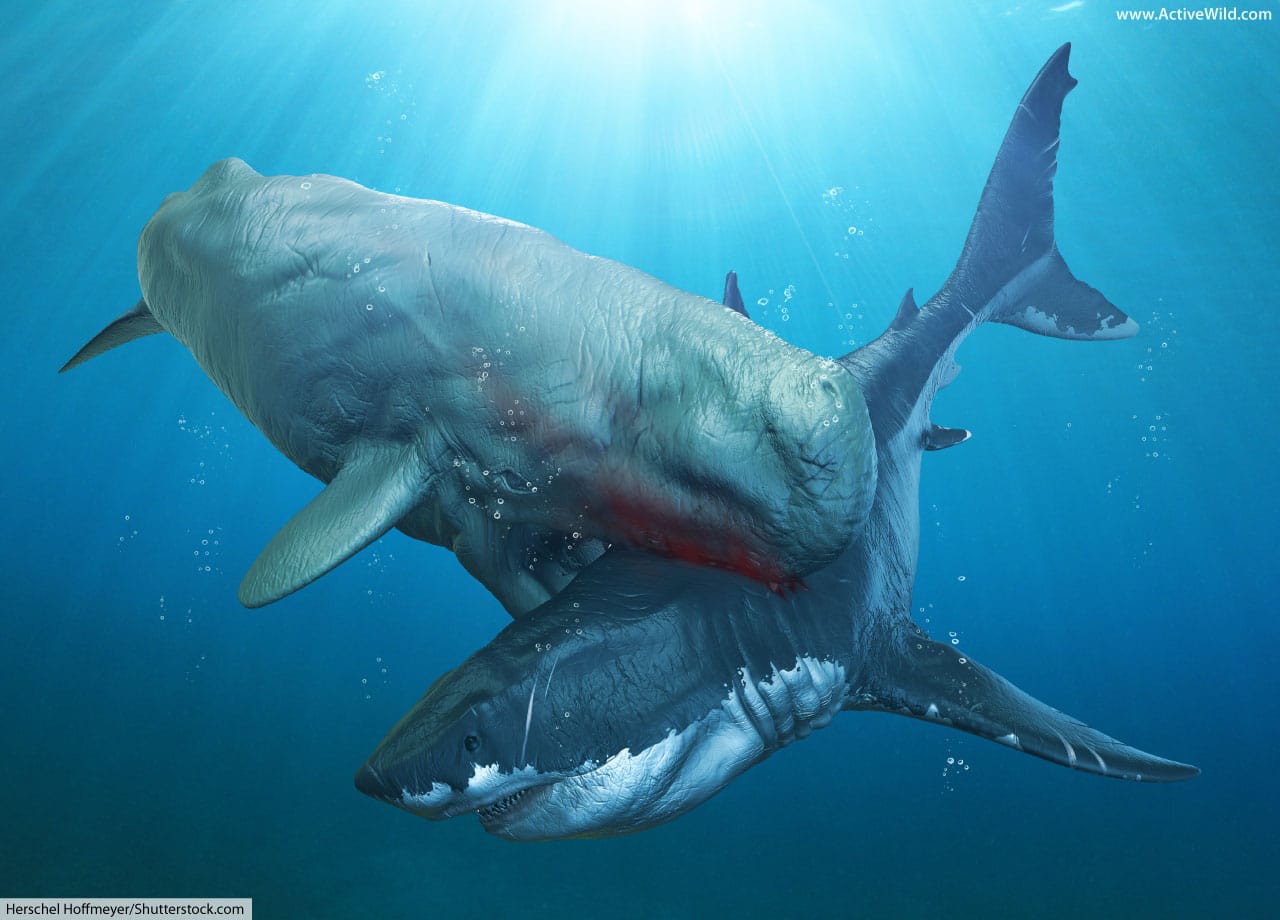Imagine plunging into the turbulent depths of the prehistoric oceans, where two titans reigned supreme: the colossal Megalodon and the mighty Livyatan. These behemoths, each a formidable predator in its own right, have captivated our imaginations, sparking endless debates about their potential encounters and who might have emerged victorious in a clash of these titans.
Which Ocean Titan Would Claim Victory?
Millions of years ago, the oceans teemed with creatures more massive and powerful than anything swimming today. Among them, Megalodon and Livyatan stand out as apex predators, their legendary status fueled by fragmented fossil discoveries that hint at their incredible size and power.
The Megalodon: A Shark of Immense Proportions
Picture a shark as long as a school bus, its jaws bristling with teeth larger than your hand—that’s Megalodon. This prehistoric predator, whose name fittingly means “big tooth,” could reach lengths of over 50 feet, dwarfing even the largest great white sharks. Its serrated teeth, some exceeding 7 inches in length, were engineered for tearing through flesh, delivering a bite force estimated at a staggering 180,000 Newtons—enough to crush bone with ease. For millions of years, Megalodon roamed the oceans, a solitary hunter capable of taking down whales and other large marine animals.
The Livyatan: A Whale Built for Battle
Livyatan, named after the biblical sea monster Leviathan, was no ordinary whale. This massive predator, estimated to have been as large as Megalodon, possessed the largest biting teeth of any known animal—some exceeding a foot in length! Unlike the filter-feeding whales common today, Livyatan was a hunter, targeting large prey, possibly even other whales. Some scientists suggest that Livyatan may have possessed a high level of intelligence and potentially hunted in pods, giving them a strategic advantage in a fight.
Clash of the Titans: Who Reigns Supreme?
The possibility of a confrontation between these two behemoths ignites the imagination—a battle for dominance in the prehistoric oceans. Who would emerge victorious? It’s a question that has captivated scientists and monster movie fans alike, each side presenting compelling arguments.
Megalodon, with its massive size and bone-crushing bite force, was undoubtedly a force to be reckoned with. Its hunting style probably involved ambush tactics, exploding from the depths to deliver a single, devastating blow.
Livyatan, on the other hand, wielded those formidable teeth, potentially even larger than Megalodon’s! Additionally, if they were intelligent and hunted in groups, a pod of Livyatan could have brought down even the largest prey, including a lone Megalodon.
The Verdict: An Unsolved Mystery
So, who wins? The fossil record, unfortunately, only provides tantalizing glimpses into the lives of these creatures. Without a time machine to witness these titans clash firsthand, the answer remains elusive. Some scientists propose that Livyatan’s potential intelligence and cooperative hunting strategies might have given them an edge, while others contend that Megalodon’s sheer size and power would be difficult to overcome.
Unlocking the Secrets of the Deep
Perhaps the greater mystery lies not in who would win a hypothetical fight, but in uncovering the secrets of how these incredible creatures lived, hunted, and ultimately vanished. Their existence speaks to the incredible diversity of life that once flourished in our oceans and underscores how much remains unknown about the prehistoric world. Each new fossil discovery brings us closer to unraveling the mysteries of these ancient titans and the epic struggle for survival that played out in the depths of the ancient seas.
Did Livyatan and Megalodon Compete?
The existence of two apex predators like Livyatan and Megalodon, both inhabiting the same oceans millions of years ago, inevitably raises the question: Did they compete?
Megalodon, the gigantic shark with a bite that could make a Tyrannosaurus Rex envious, and Livyatan, the enormous sperm whale with teeth bigger than your hand, both prowled the warm oceans of the Miocene Epoch. Megalodon’s reign lasted from about 23 to 3.6 million years ago, while Livyatan roamed the seas from 13 to 9.9 million years ago. This significant overlap in their timelines makes it highly probable that their paths crossed.
Both predators were built for hunting. Livyatan’s teeth, some exceeding a foot in length, were the largest biting teeth of any known animal. Megalodon, on the other hand, possessed serrated teeth, like rows of steak knives, perfect for ripping through flesh. Its powerful tail propelled it through the water with incredible speed, making it a formidable hunter.
Given their massive size, overlapping territories, and predatory nature, it’s highly likely that Livyatan and Megalodon competed for resources. Direct confrontations, while possible, are difficult to prove definitively. Fossil evidence primarily consists of teeth and bone fragments, offering limited insights into their interactions.
However, we can draw parallels from modern predator dynamics. The presence of one apex predator can influence the behavior and evolution of others. It’s possible that Livyatan’s existence spurred Megalodon to evolve in certain ways, and vice versa, creating an underwater arms race.
While definitive answers remain elusive, the fossil evidence, combined with our understanding of predator-prey relationships, strongly suggests that Livyatan and Megalodon were likely rivals, their presence shaping the ancient oceans they ruled. Every new fossil discovery brings us closer to understanding these magnificent creatures and the complex web of life they were a part of.
For a deeper dive into the fascinating comparison between Livyatan and Megalodon, explore this insightful article: Livyatan vs Megalodon.
Was Leviathan Larger than Megalodon?
The question of size is a common thread in discussions about prehistoric creatures. When it comes to Leviathan and Megalodon, determining which was larger is a challenge that continues to fascinate researchers.
Reconstructing the size of these prehistoric behemoths relies on incomplete skeletons and scattered teeth, making it akin to solving a puzzle with missing pieces. However, scientists have developed methods to estimate the size of both Megalodon and Leviathan.
Current scientific consensus suggests that both predators likely reached lengths of around 50-60 feet. That’s about the length of a bowling lane! However, when it comes to weight, Leviathan might have held a slight edge. Imagine a lean, muscular athlete (Megalodon) facing off against a powerful, heavy-weight boxer (Leviathan).
While their hunting styles likely differed—Megalodon with its speed and powerful bite, and Leviathan with its massive size and powerful jaws—both were apex predators that shaped their marine ecosystems.
Although we may never be entirely certain about the definitive winner in a size comparison, evidence suggests that Leviathan and Megalodon were relatively evenly matched in length, with Leviathan possibly having a slight weight advantage.
The ongoing quest to understand these prehistoric titans and their impact on the ancient oceans highlights the awe-inspiring history of our planet. While their story is still being written with each new fossil discovery, one thing is clear: Leviathan and Megalodon continue to captivate our imaginations and remind us of the incredible creatures that once roamed our planet.
Interested in the fascinating story of exploration and discovery? Delve into the remarkable journey of Marsden and Geiger in New Zealand: Marsden and Geiger.
What Could Have Defeated Leviathan?
Leviathan, the massive prehistoric sperm whale, may have been an apex predator, but even giants have their vulnerabilities. So, what could have challenged this ruler of the ancient seas?
Megalodon: A Heavyweight Contender
A clash between Leviathan and Megalodon—the largest shark to ever exist—would have been a battle for the ages. Megalodon’s sheer size, estimated at up to 60 feet in length, could have given it an edge in a direct confrontation. Moreover, its razor-sharp, serrated teeth were designed to tear through flesh, making even a glancing blow from a Megalodon a serious threat to a Leviathan.
Leviathan vs. Leviathan: Battles for Supremacy
Even the mightiest predators face competition from their own kind. Like some whale species today, Leviathan probably engaged in intense battles for dominance, territory, or mates. These battles, evidenced by scars and injuries found on fossil remains of similar whales, could have been brutal, sometimes leading to death.
Invisible Threats: A Changing World and Tiny Enemies
Sometimes, the most significant threats are the least visible. Climate change, for example, could have dramatically impacted Leviathan’s food supply, making survival difficult. Disease and parasites, though invisible to the naked eye, can weaken and even kill even the largest animals.
Vulnerable Beginnings: Easy Prey for Opportunistic Predators
Even Leviathan started small. As adorable as a baby Leviathan might sound, these youngsters would have been prime targets for oceanic predators. Smaller and less experienced than adults, baby Leviathans would have been a tempting target for sharks and other large predators.
Our understanding of Leviathan and its world is constantly evolving as new fossil discoveries come to light. While we can speculate about the threats it faced, the mysteries surrounding this incredible predator continue to fascinate and inspire further exploration of the prehistoric oceans.
Key Points to Remember:
- Megalodon:
- Giant shark, potentially reaching over 50 feet in length.
- Possessed enormous serrated teeth exceeding 7 inches in length.
- Estimated bite force of 180,000 Newtons, capable of crushing bone.
- Likely an ambush predator, targeting large marine animals.
- Leviathan:
- Whale reaching sizes comparable to Megalodon, up to 57 feet long.
- Equipped with the largest biting teeth of any known animal, exceeding a foot in length.
- May have been intelligent and capable of cooperative hunting behavior.
- Hunted large prey, potentially including other whales.
- Clash of the Titans:
- Both creatures possessed unique advantages and disadvantages.
- Megalodon’s size and bite force versus Leviathan’s teeth and potential teamwork make it a close call.
- Limited fossil evidence makes it impossible to determine a definitive victor.
- Beyond the Battle:
- Fossil discoveries offer glimpses into the lives, hunting behavior, and eventual extinctions of these ancient behemoths.
- Their existence highlights the vast diversity and lingering mysteries of prehistoric marine life.
By incorporating these key points, rich details, and internal links within the text, you can create a comprehensive and engaging article that will captivate your audience and rank well in search engine results.
- Discover Long Black Pepper: Flavor & Health Benefits - April 25, 2025
- Shocking Twists: The Grownup Review: Unreliable Narration - April 25, 2025
- A Quiet Place Book vs Movie: A Deep Dive - April 25, 2025
















2 thoughts on “Megalodon vs. Livyatan: The Ultimate Battle of Prehistoric Ocean Titans”
Comments are closed.